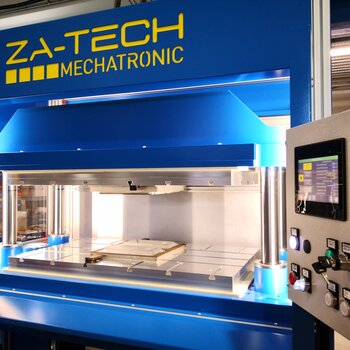Cutting | Trimming | Sawing
Yaskawa Slovenia Študije primerov Aplikacije Cutting | Trimming | Sawing
Pregled
Material Cutting Applications with Motoman Robots
Cutting material is a wide field for robotic automation. The target is the same - cutting parts to a defined length or shape, or deburring or trimming parts after moulding processes.
Cutting applications are becoming automated regularly these days. While some companies choose a flatbed cutter for their cutting applications, others are starting to see the benefits of using six-axis robots for this process.
This web page section is focussing mechanical cutting (with knives), sawing, ultrasonic cutting / trimming, waterjet cutting, plasma cutting, laser cutting, using mechanical knives or media for cutting. Deburring and trimming can also be executed with material removal tools which is topic of our material removal web page section.
Robots do either loading/unloading parts to cutting machines, or they are handling the cutting tool directly.
Robotic Cutting with Mechanical Cutting Tools (Motoman GP Series)
Opening Carton Boxes - Cutting Foam of car seats - Perforating bags to open them - these are application examples for mechanical cutting with Motoman Handling Robots.
Cutting Operations can be done with milling heads. For more information on milling, please go the "Material Removal" section of our website.
Sawing with Motoman Robots (GP Series)
In most cases, the robot is handling workpiece to a stationary saw.
Wooden Panels are loaded to a conveyor table, before they are transported into the saw.
Ultrasonic Cutting / Trimming with Motoman Robots (GP Series)
Ultrasonic cutting uses ultrasonic electric pulses to slice through objects. In comparison to other cutting methods, it creates finely finished and structured objects. It is well suited for all materials which may not be exposed to heat during the cutting process, including plastics, natural and synthetic fibers or rubber.
Robotic ultrasonic trimming is widely used for Car Interior trim parts, such as moulded plastic panels which require deburring and cutouts which cannot be generated in the moulding tool itself.
For trimming of dashboards and instrumental panels, simple turntable stations are best choice, using one of our Motoman two station positioners.
Robot carpet cutting stations are taking advantage of the robot's flexibility and easy re-programming of the patterns. Often, programming is done via CAD/CAM tools with specific trimming software add-ons. You will find Motoman Robots in the libraries of the leading CAD/CAM software vendors.
Waterjet Cutting (with Motoman GP Series Robots)
Waterjet cutting can be used for a wide variety of materials, using a high pressure of water, or a mixture of water with abrasive ingredients. Materials commonly cut with water jet robots include textiles, rubber, foam, plastics, leather, composites, stone, tile, glass, metals, food, paper, (automotive) carpets and much more.
Plasma Cutting (with Motoman GP Series Robots)
Plasma cutting is a process that cuts through electrically conductive materials by means of an accelerated jet of hot plasma. Typical materials cut with robots carrying plasma torches include steel, stainless steel, aluminium, brass and copper, although other conductive metals may be cut as well. The plasma cutting process is pretty fast and requires good speed and path performance from the robots, specifically at re-orientation points of the TCP in edges. Due to their fast IPO cycle, Yaskawa YRC1000 high performance controllers with Motoman Robots are best suited for this job.
Large Panels require long reach robots - a job for the GP20HL.
Also here, Motoman robots combined with one of our 2-station-positioners are perfect to build automated robotic cells.
Laser Cutting (with Motoman GP Series Robots)
In most laser cutting applications, the robot is loading/unloading metal sheets to the bed of a laser cutting machine. The working range of the Motoman robot can be expended by using high speed TSL Tracks, fully integrated as a 7th axis into the robot controller YRC1000.
Here are two examples where the robot is moving the laser cutting tool. The classic application is to cut Car Body Frame Beams to compensate tolerance chains.




















